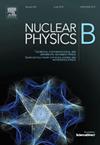维耶尔拜因形式主义中的米尔扎库洛夫引力:Weitzenböck时空中的研究
IF 2.8
3区 物理与天体物理
Q2 PHYSICS, PARTICLES & FIELDS
引用次数: 0
摘要
为了理解引力的本质及其在塑造宇宙中的作用,人们对修正的引力理论进行了探索。这一领域的开创性贡献之一是Myrzakulov引力理论,它结合了曲率和扭转。在这项工作中,我们在f(R,T)-重力的框架内研究了扭转的影响,这是广义相对论的一个修正,包含了曲率和扭转。我们在Vielbein形式中提出了这一理论,这是一种协变方法,提供了更灵活和几何的重力视角,确保了理论在一般坐标变换下的一致性。这种形式在Weitzenböck时空的背景下特别强大,在那里扭转在引力相互作用的描述中起着重要作用。通过研究Vielbein形式主义中的f(R,T)-gravity,我们的目标是扩展Myrzakulov理论的适用性,为其宇宙学和天体物理学意义提供更深入的理解。我们研究了这一理论对各种天体物理现象的深远影响,包括黑洞、引力波和像中子星这样的致密物体。通过探索扭转如何改变这些极端系统的行为,我们发现了在强场状态下测试重力的新途径。我们的研究结果表明,扭转可能导致黑洞热力学、引力波传播和致密物质结构的可观测偏差。我们发现的这些变化有可能为了解时空和引力的本质提供前所未有的见解,为研究支配宇宙的基本力量提供一个新的视角。这项工作为未来的观测和理论研究铺平了道路,这些研究可能会揭示引力更深层次、隐藏的方面,可能会改写我们对宇宙中最神秘现象的理解。通过观测数据和理论的进步,我们为探索f(R,T)引力提供了一个令人信服的案例,作为寻找超越广义相对论的新物理学的有力工具。本文章由计算机程序翻译,如有差异,请以英文原文为准。
Myrzakulov gravity in vielbein formalism: A study in Weitzenböck spacetime
The quest to understand the nature of gravity and its role in shaping the universe has led to the exploration of modified gravity theories. One of the pioneering contributions in this field is the Myrzakulov gravity theory, which incorporates both curvature and torsion. In this work, we investigate the effects of torsion within the framework of -gravity, a modification of General Relativity that incorporates both curvature and torsion.
We present this theory in the Vielbein formalism, a covariant approach that provides a more flexible and geometric perspective on gravity, ensuring the theory's consistency under general coordinate transformations. This formalism is particularly powerful in the context of Weitzenböck spacetime, where torsion plays a significant role in the description of gravitational interactions. By studying -gravity in Vielbein formalism, we aim to extend the applicability of Myrzakulov's theory, providing a deeper understanding of its cosmological and astrophysical implications.
We examine the profound effects of this theory on various astrophysical phenomena, including black holes, gravitational waves, and compact objects like neutron stars. By exploring how torsion modifies the behavior of these extreme systems, we uncover new avenues for testing gravity in the strong-field regime. Our results suggest that torsion could lead to observable deviations in black hole thermodynamics, gravitational wave propagation, and the structure of dense matter.
The modifications we uncover have the potential to provide unprecedented insights into the nature of spacetime and gravity, offering a novel perspective on the fundamental forces that govern the cosmos. This work paves the way for future observational and theoretical studies that could reveal the deeper, hidden aspects of gravity, possibly rewriting our understanding of the universe's most enigmatic phenomena. Through both observational data and theoretical advancements, we present a compelling case for the exploration of -gravity as a powerful tool in the search for new physics beyond General Relativity.
求助全文
通过发布文献求助,成功后即可免费获取论文全文。
去求助
来源期刊

Nuclear Physics B
物理-物理:粒子与场物理
CiteScore
5.50
自引率
7.10%
发文量
302
审稿时长
1 months
期刊介绍:
Nuclear Physics B focuses on the domain of high energy physics, quantum field theory, statistical systems, and mathematical physics, and includes four main sections: high energy physics - phenomenology, high energy physics - theory, high energy physics - experiment, and quantum field theory, statistical systems, and mathematical physics. The emphasis is on original research papers (Frontiers Articles or Full Length Articles), but Review Articles are also welcome.
 求助内容:
求助内容: 应助结果提醒方式:
应助结果提醒方式:


